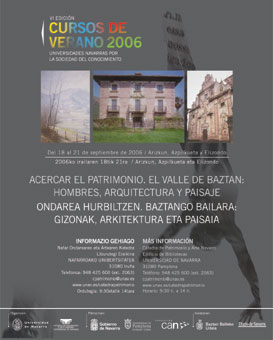BRINGING HERITAGE CLOSER. THE BAZTAN VALLEY: MEN, ARCHITECTURE AND LANDSCAPE
19 September 2006
From the village to the Court
Dr. José María Imízcoz Beunza. University of the Basque Country

The "18th century Navarrese hour" was not an isolated event. It resulted from the meeting between some family groups, mostly from the valleys of the North of Navarre, and the more general movement that took place in the Hispanic Monarchy with the advent of the Bourbons. This renewal at the top of the monarchy opened a considerable political and economic space that facilitated the elevation of numerous families of northern noblemen to the highest political and honorary positions. The most striking case, due to its intensity and issue, is that of the several hundred people from Baztan who, throughout the 18th century, made careers and businesses in the Court, the High Administration, the hierarchy of the Army and the Navy, the high clergy, royal finances and peninsular and colonial commerce.
From an initial instructions , the policy of these families was based on the systematic placement of their sons in commerce and royal administration, thanks to the sponsorship of their collateral relatives. Very soon, after the successes of the first generation of "the eighteenth hour", a number of families established themselves in a conscious and systematic policy of giving certain careers to their sons. This policy relied on family relationships introduced into the businesses and institutions of the monarchy and required an educational and economic investment. The children learned Spanish and how to read, write and count. They could then attend various courses programs of study. The expenses of this Education were paid by the relatives who were in charge of placing them. In addition, those who had prospered in the Structures of the Monarchy created and financed schools of first letters in the towns to provide this Education to their relatives and countrymen.
Between the relatives established in the Court and in the empire and their families of the Baztan a powerful Economics of communicating vessels was established. Through it, abundant resources arrived, especially if we compare them with the limited possibilities of the traditional rural Economics . The families that participated in this process rebuilt their houses, giving them Issue and prestige, improved their farms, bought land, founded censuses, received dowries to marry off their daughters in good marriages or to enter a convent, etc. The money did not come only through inheritance or donations, but regularly, through monthly pensions.
The families whose sons rose to prominence in "the time of the XVIIIth century" also rose strongly in the society of Baztan. The careers of their sons in the Monarchy brought them economic, honorary and political benefits that largely fed their rise within the peasant community. They became the main families of the Valley, took charge of the local government, represented their prestige through material and honorary elements, practiced a paternalistic policy through a very abundant patronage and acted as useful mediators between the outside world and the needs of the peasant society.

PROGRAM
MONDAY, 18 SEPTEMBER
Place: Elizondo. Arizkunenea Cultural Centre
16.45 h: Opening and presentation of the course
17 h. Juan de Goyeneche, ahead of his time
Prof. Dr. Alfredo Floristán Imízcoz. University of Alcalá de Henares
18 h. Coffee break
18.30 h. Ziga, Lekaroz and Gartzain: the churches of the Renaissance in the Baztan area
Prof. Dr. María Josefa Tarifa Castilla. Chair of Navarrese Heritage and Art
TUESDAY, 19 SEPTEMBER
Place: Elizondo. Arizkunenea Cultural Centre
17 h. From the village to the Court
Prof. Dr. José María Imízcoz Beunza. University of the Basque Country
18 h. Coffee break
18.30 h. Palaces of Baztan
Prof. Dr. Pilar Andueza Unanua. Chair of Navarrese Heritage and Art
Then visit to the Ethnographic Museum of Baztan Jorge Oteiza, guided by Ms. Ana María Marín, member of the Friends of the Museum.
WEDNESDAY, 20TH SEPTEMBER
Place: Arizkun. Convent of the Poor Clares
17 h. Juan Bautista Iturralde and his foundations
Prof. Dr. María Concepción García Gainza. Chair of Navarrese Heritage and Art
Place: Azpilkueta. Parish
18.30h. Families and artistic promotion: Elizacoechea in Azpilkueta, the Jáuregui family in Oharriz
Prof. Dr. Ricardo Fernández Gracia. Chair of Navarrese Heritage and Art
THURSDAY, 21ST SEPTEMBER
Place: Elizondo. Arizkunenea Cultural Centre
17 h. Indian art and architecture in the Baztan Valley. The 19th and 20th centuries
Prof. Dr. Javier Azanza López. Chair of Navarrese Heritage and Art
18 h. Coffee break
18.30 h. Closing session: The Bidasoa School and landscape painting in Baztania.
Prof. Dr. Francisco Javier Zubiaur Carreño. Museum of Navarre
